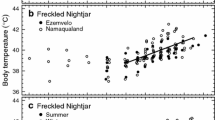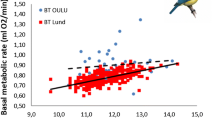Summary
-
1.
The regulation of O2-consumption and body temperature, especially the occurrence and utilization of nocturnal hypothermia, was studied in three small-sized northern species of birds occupying different ecological niches. Being sympatric, the Willow titParus montanus, the Great titP. major and the Common redpollAcanthis flammea encounter the same environmental conditions during the winter-time, i.e. long nights, low ambient temperatures, a snow-cover, and the possibility of periods of food shortage.
-
2.
When fed ad libitum, neither the Great tit nor the Common redpoll utilized nocturnal hypothermia. The Willow tit lowered the body temperature to a value which was significantly correlated with that of the ambient temperature.
-
3.
During fasting experiments the evening body weights of the birds were depleted 10–20% below the normal value. In all three bird species the O2-consumption during the night was positively correlated to the body weight of the birds. Consequently, the depth of hypothermia achieved at thermal homeostasis was inversely correlated to body weight.
-
4.
When energy reserves in terms of body weight, are less than normal, both Willow tit, Great tit and Common redpoll utilize nocturnal hypothermia in order to make the energy reserves last throughout the night. The reason why the latter two species, in contrast to the Willow tit, do not use nocturnal hypothermia under normal conditions, may be due to differences in body size and also feeding strategies.
Similar content being viewed by others
References
Aschoff J, Pohl H (1970) Rhythmic variations in energy metabolism. Fed Proc Fed Am Soc Exp Biol 29:1541–1552
Bartholomew GA, Vleck CM, Bucher TL (1983) Energy metabolism and nocturnal hypothermia in two tropical passerine frugivores,Manacus vitellinus andPipra mentalis. Physiol Zool 56:370–379
Biebach H (1977) Das Winterfett der Amsel (Turdus merula). J Ornithol 118:117–133
Brooks WS (1968) Compartive adaptations of the Alaskan redpolls to the arctic environment. Wilson Bull 80:253–280
Bucher T, Worthington A (1982) Nocturnal hypothermia and oxygen consumption in Manakins. Condor 84:327–331
Calder WA (1974) Consequences of body size for avian energetics. In: Paynter RA Jr (ed) Avian energetics. Cambridge Publ, Nutall
Chaplin SB (1976) The physiology of hypothermia in the blackcapped chickadee,Parus atricapillus. J Comp Physiol 112:335–344
Chaplin SB, Diesel DA, Kasparie JA (1983) Body temperature regulation in Red-tailed Hawks and Great Horned Owls: responses to air temperature and food deprivation. Condor 86:175–181
Dawson WR, Hudson JW (1970) Birds. In: Whittow GC (ed) Invertebrates and nonmammalian vertebrates (Comparative physiology of thermoregulation, vol 1). Academic Press, New York, London, pp 223–310
Depocas F, Hart JS (1957) Use of the Pauling oxygen analyzer for measurement of oxygen consumption of animals in opencircuit systems and in a short-lag, closed-circuit apparatus. J Appl Physiol 10:388–392
Grossman AF, West GC (1977) Metabolic rate and temperature regulation of winter acclimatized black-capped chickadeesParus atricapillus in interior Alaska. Ornis Scand 88:127–138
Haftorn S (1956) Contribution to the food biology of tits especially about storing of surplus food. Part III. The willow-tit (Parus atricapillus). K. norske Vidensk Selsk Skr 1956(3):1–79
Haftorn S (1958) Opplysninger om stedbundethet og ‘totalrevir’ hos toppmeis,Parus cristatus L., og granmeisP. montanus Bald. (Local movements and “total range” inParus cristatus L. andParus montanus Bald.). K norske Vidensk Selsk Forh 30:144–149
Haftorn S (1972) Hypothermia in tits in the arctic winter. Ornis Scand 3:153–166
Hainsworth FR, Collins BG, Wolf LL (1977) The function of torpor in hummingbirds. Physiol Zool 50:215–222
Heller HC, Glotzbach SF (1977) Thermoregulation during sleep and hibernation. Int Rev Physiol 15:147–187
Hudson JW (1978) Shallow, daily torpor: a thermoregulatory adaptation. In: Wang LCH, Hudson JW (eds) Strategies in cold: natural torpidity and thermogenesis. Academic Press, New York
Mohus I (1983) Temperature telemetry from small birds. Ornis Scand 14:273–277
Mrosovsky N (1971) Hibernation and the hypothalamus. Appleton Century Crofts, New York
Pauritsch G (1982) Freilanduntersuchung über die Körpertemperatur einheimischer Kohlmeisen (Parus major L.) im Winter. Ökol Vögel 4:175–180
Pohl H (1972) Seasonal change in light sensitivity inCarduelis flammea. Naturwissenschaften 59:518
Reinertsen RE (1982) Radio telemetry measurements of deep body temperature of small birds. Ornis Scand 13:11–16
Reinertsen RE (1983) Nocturnal hypothermia and its energetic significance for small birds living in the arctic and subarctic regions. A reviev. Polar Resns 1:264–284
Reinertsen RE, Haftorn S (1983) Nocturnal hypothermia and metabolism in the Willow titParus montanus at 63°N. J Comp Physiol 151:109–118
Reinertsen RE, Haftorn S (1984) The effect of short-time fasting on the metabolism and nocturnal hypothermia in the Willow titParus montanus. J Comp Physiol B 154:23–28
Steen JB (1958) Climatic adaptation in some small northern birds. Ecology 39:625–629
Wolf LL, Hainsworth FR (1972) Environmental influence on regulated body temperature in torpid hummingbirds. Comp Biochem Physiol 41:167–173
Author information
Authors and Affiliations
Rights and permissions
About this article
Cite this article
Reinertsen, R.E., Haftorn, S. Different metabolic strategies of northern birds for nocturnal survival. J Comp Physiol B 156, 655–663 (1986). https://doi.org/10.1007/BF00692743
Accepted:
Issue Date:
DOI: https://doi.org/10.1007/BF00692743




